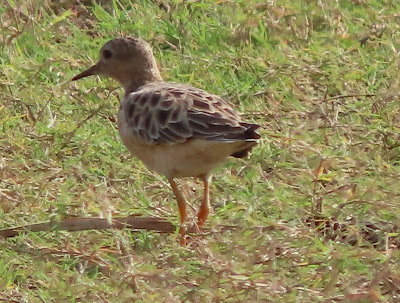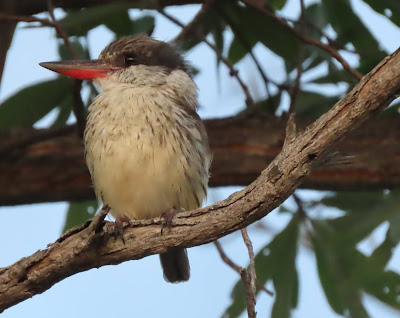With Boksburg's temperatures dropping it was time for this swallow to head for warmer climes. A major rarity had turned up at Mpempe Pan in Zululand and provided a good excuse to visit Mkuse for a couple of nights. Shortly after arrival I took a sundowner to Masinga Pan which apparently had another rarity in residence. Though I failed to find bird, it was grand to be back in the bush.
Mpempe was about an hours drive from Mantuma Camp where I was staying in a rondavel. Thank heavens for GPS or I'd never have found the spot and no sooner had I arrived than another vehicle pulled up. I said to the gent who emerged that I was sure we weren't both there by coincidence and he confirmed he was also chasing the bird. He introduced himself as Mans Booysen, one of the foremost birders in the country. I knew of him but had never met. We split up to widen the net and amongst many other waders I found a couple of Temminck's coursers - always a pleasure to see.
Realizing that I'd left my water bottle in the vehicle, I returned and was indulging in a glug when something 10 m away caught my eye. If I remember correctly, this is only the 15th time that a buff-breasted sandpiper has been recorded in Southern Africa so it really was something to find. I called Mans and another group who had just arrived over.........
.....and we'd taken a couple of shots each and were moving to get the sun behind us, when the brute took off. After swanning around for half an hour, I noticed the other group had returned to a spot close to where it had been previously. We both arrived back and were able to shoot at leisure as the bird was totally relaxed. Mans later thanked me and remarked that there were very few people who could show him a new species as this was his 905th for Southern Africa! I replied that I was going to put that in my CV.
After that rush, back to the more mundane, a lovely little striped kingfisher that I found on the way back to the camp.
Every time I see this particular tree I just have to have a picture, so you may have seen it before, however isn't it a magnificent specimen of umbrella thorn A. tortilis and I totally refuse to use that vulgar Vachellia name.
On the way home another beauty not often seen, the nocturnal bronze-winged courser. Think whoever named them locked onto a less obvious feature as only the first two primaries have a small bronze tip, Far more striking are the violet and gold tipped secondaries, which are only visible in flight.
The following morning I took a stroll around the camp and came across this rather tatty orange tip. I find it amazing that butterflies can loose up to a third of their wing area and still fly effortlessly.
These 40 cm across stapelias (S. gigantica) are characterized by their rotting flesh scent which attracts their major pollinators - flies.
A series of beautiful calls brought me to this bearded scrub robin who was so full of himself he didn't take much notice of me......very special.
It made the black flycatcher in the tree next to him look rather dull.
On the way out a small group of young impala caught my eye. Most would go "Oh no not more impala" but I think they are one of the prettiest antelopes........
..........and a little further along a crested francolin and chicks - such a proud looking parent.
This is the aptly named scarlet gourd Coccinia sp. produces a small cucumber shaped fruit of a spectacular hue......
....while the grasslands were alive with little bronze mannikins.
Sitting having a drink with the Turner's one evening, I spied this 60 mm beaut trundling across the carpet. I assumed it must be someone's pet tarantula, but it turned out to be a local baboon spider which I have never had the pleasure of meeting before. A member of the theraphosidae family they are rarely seen but not at all aggressive unless threatened.
A couple of nights later sundowners featured a full moon (top right) and a rainbow.
The local conservancies had open days one weekend and we trundled up to Monteseel and had a pleasant amble along the edge of the gorge above the Valley of a Thousand Hills. Impressive drop, and thanks Brigid for the two previous ones and this picture.
The same was true for the white-eared barbet and they have also increased their range probably due to the proliferation of gardens with old trees and some dead wood for them to drill their nest holes into.























